The Reichsluftfahrtministerium Volksjäger (“People’s Fighter”) design competition was issued on September 10th, 1944 by the German Ministry of Aviation (Reichsluftfahrtministerium – RLM) to develop an inexpensive, mass produced emergency light jet fighter that was fast but easy to fly, to combat the Allied bomber offensive that was devastating Germany. Designs were to be returned by German aviation manufacturers within just 10 days and production was to commence by January 1st, 1945!
Heinkel Flugzeugwerke GmbH were already working on similar designs and wind tunnel testing with their P.1073 design, thus given their more advanced status over other manufacturers, they won the competition by submitting a modified design to meet RLM requirements. The competing Blohm & Voss P.211 design had better visibility, as the engine was within the fuselage but was deemed to be more complex and would have taken longer to get into production.
The Volksjäger program which was born out of desperation in Germany during an interesting time in history. Although an inevitable end to the war in Europe was fast approaching, it was at the height of German aviation technical advances and jet engines were an irresistible incentive to produce yet another of Hitlers Wunderwaffe (“Miracle Weapon” aka Wonder Weapons) to stave of total defeat. The program had the consent of Luftwaffe Minister Hermann Goering and Armaments Minister Albert Speer, and went ahead despite being against the wishes of Luftwaffe Generals in the know, such as the legendary Adolf Galland who wanted proven new aircraft, such as the Me 262 jet fighter to be the sole focus of German factories, and not yet another program to drain now very limited resources.
The result from the P.1073 design was the sleek and futuristic looking Heinkel He 162A Volksjäger (“People’s Fighter”) known at Heinkel as the Spatz (“Sparrow”) but often referred to as the Salamander (the He 162 construction program codename was Salamander – the name was based on mythological aspects in folklore of the salamander being immune to fire). The He 162 was intended in 1945 to be a cheap fighter utilising the latest jet engine technology for the Luftwaffe and as metal was in short supply, made mostly of wooden construction so they could be mass produced in the thousands by semi-skilled labour to take on the seemingly never ending Allied bomber offensive.
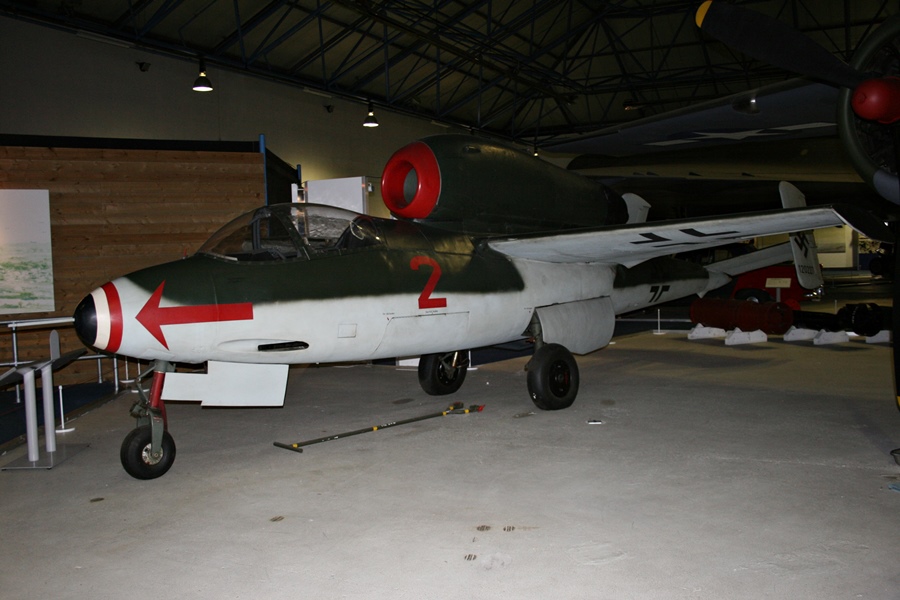
The He 162 was powered by a BMW 003 axial flow turbojet engine installed above the fuselage with a tail fitted with twin vertical stabilisers to accommodate the jet exhaust. You obviously would not want to bail out of a cockpit with a jet intake right behind it, so Heinkel installed one of the first versions of an ejector seat, which was powered by an explosive charge to clear the aircraft!
In theory it was a good concept to create and mass produce a “People’s Fighter” but the overarching plan to quickly train inexperienced Hitler Youth as pilots in gliders (yes gliders!), to make up the void in available Luftwaffe pilots and form Volksjäger squadrons, then expect them to fly a jet fighter with basic controls quickly towards Allied bombers, with the ability to also combat or escape Allied escort fighters as required was absolutely insane! The delusional belief that these kids could not only fly into combat but also in a leading edge aircraft in the dawning of the jet age, was a classic example of the nearing end of the Third Reich and it’s Nazi regime! Even well trained, highly experienced and battle hardened Luftwaffe aces were still struggling to come to grips with handling and even landing the Messerschmitt Me 262 Schwalbe jet fighter, yet alone throwing kids into a jet cockpit!
Fortunately the Hitler Youth flight training program for the He 162 was only beginning to form at Sagan, Germany in March 1945 and no training was actually completed before the end of the war in May 1945. Trained Luftwaffe pilots would go on to fly the “Peoples Fighter“.
Production and Development
Heinkel were awarded the production contract for the He 162 on September 30th, 1944 and final assembly work had begun on prototype aircraft at the Heinkel production facility in Austria. The first prototype test flight was conducted on December 6th, 1944 with Heinkel’s chief test pilot Flugkapitän Gotthold Peter, flying He 162 V1 at Schweckat-Heidfeld Airfield near Vienna, Austria. During this first flight, he reached a speed of 840km/h (520mph) but defective glue bonding caused an issue with the nose wheel landing gear door and also flight instability was detected with the tail rudder design.

The second test flight of the prototype on December 10th, 1944 ended in disaster due to the ongoing issues with the glue bonding. Part of the right wing separated, causing the prototype to roll and crash, killing Flugkapitän Gotthold Peter. Despite such a setback, this did not stop further testing and production was to go ahead regardless. A few minor modifications were made including nose ballast to adjust the centre of gravity, strengthened wings with the notable anhedraled aluminium downward wingtips to improve stability and enlarging the tail surfaces but essentially the original design was kept due to the limited timeframe available and the first He 162 entered Luftwaffe service soon after in January 1945.
The He 162 was fast and well armed for such a small fighter. The BMW 003E-1/2 axial flow turbojet engine was capable of producing a maximum speed of up to 905 km/h (562 mph) for short bursts at altitude – this was an engine that was more readily available for the project as it was not used in mainstream production of the Me 262 or the Arado Ar 234 Blitz jet bomber, which both primarily used the more powerful Junkers Jumo 004 turbojet engine. Armament consisted of two cannons – either heavy hitting 30 mm Mk 108 cannons for the A-1 bomber interceptor variant (which proved to have too violent recoil for the lightweight wooden airframe) or 20 mm MG 151/20 for the A-2 fighter variant (lighter and more ammunition could be carried).
Apart from structural weaknesses, a major achilles heel of the He 162 design was its limited range and flight time. Endurance was limited to just 30 minutes due to the small airframe only accommodating a 695 litre (183 US gallon) flexible bladder fuel tank – this was a dangerously short time and pilots reportedly died attempting to land with no fuel or engine power.
Although a few A-1 bomber interceptor variants were produced, the A-2 fighter became the primary production variant. A proposed A-3 variant was intended to have structural strengthening to better cope with the recoil of the 30mm cannons. A small number of unarmed He 162S two-seat gliders were also built for training Hitler Youth pilots but are likely to have seen little use due to the late formation of the training unit (probably only 2 to 3 were built).
Approximately 320 He 162A were completed with possibly up to 600-800 more still on the production line awaiting completion, mostly in converted salt mine caverns and underground factories in Austria (Salzburg and the Heinkel Hinterbrühl facility) and Germany (primarily at the Heinkel North factory in Rostock and at Mittelwerk GmBH in Norhausen). Parts were produced in dozens of dispersed smaller factories for final assembly at larger production facilities. They were built underground to avoid Allied bombing.
Only 120 He 162 were actually delivered to the Luftwaffe and due to Allied bombing and the stage of the war, there was really no hope of mass producing the aircraft or providing pilots, ongoing spare parts, engines or fuel to keep them flying. Unrealistic plans were in place to initially produce 1,000 aircraft per month, then increase this to 2,000+ per month when new production facilities became available!

Operational Deployment
Erprobungskommando 162 (EK 162) was formed as a test unit for the new Heinkel He 162A in January 1945 at Rechlin-Roggenthin in Germany under the command of famous ace Heinz Bär (220 air to air victories). By May 1945 EK 162 had joined the elite JV 44 Me 262 unit near Salzburg, Austria but it seems the aircraft were never used operationally. The small number of He 162 aircraft operated by the unit were destroyed towards the end of the war to avoid them falling into Allied hands upon their surrender on May 3rd, 1945.
Jagdgeschwader 1 (Fighter Wing 1) flying Messerschmitt Bf 109 and Focke-Wulf Fw 190 fighters had been battered on both the Western and Eastern fronts in 1944 and in early 1945 had been assigned to the Luftflotte Reich (Air Fleet Reich) to defend German air space. By May 1945 a small number of He 162A jets had entered operational service with JG 1 but were essentially in operation as a training unit.
Staffel I./JG 1 received the type from February 1945 and had begun training in the type for operation at Parchim in March 1945. Numerous pilots were killed in training accidents in the new jet fighter. By April 1945, Allied bombing of airfields saw the unit on the move to Ludwigslust and then Leck near the Danish border. Staffel II./JG 1 began receiving the type at Rostock-Marienehe near the Heinkel factory in April 1945. Both were operating as the combined I. (Einsatz)/JG 1 from Leck by the end of April 1945 with approximately 50 aircraft and pilots. JG 1 surrendered and handed over their aircraft following the end of the European war upon Germany’s total surrender on May 5th, 1945.
The He 162A reportedly saw some success in its few months of operation with JG 1, with three pilots claiming air to air victories over British aircraft but only one was adequately confirmed when Lt. Rudolf Schmitt shot down an RAF Hawker Tempest in early May 1945. He was also the first pilot to use the ejection seat of the He 162 and survive when he had to bail out on April 20th, 1945 – JG 1 pilots deployed the ejection seat under operational conditions at least three times during April 1945, with one pilot unfortunately not surviving when the cockpit canopy did not detach.
The Heinkel 162A, like all early German jets, required careful and smooth handling movement (especially the rudder control) and careful engine throttle management. During its operational deployment, JG 1 aircraft and pilots were lost due to jet engine flameouts, structural failures and Allied air attack (approximately 10 pilots and 13 aircraft were lost, with at least one aircraft destroyed following take-off by an RAF Hawker Tempest fighter-bomber on April 19th, 1945 whilst targeting jet fighters at their most vulnerable moment, flying slowly upon take-off or landing). The aircraft was a good performer but acidic glue sealant issues which damaged the wooden airframe and rushed production was said to be a contributing issue. A shortage of pilots and the effects of the Allied bombing offensive on production, turbojet engines, parts and fuel supply also hampered the deployment of the Volksjäger (“People’s Fighter”) and JG 1 was never able to fly the aircraft in any numbers or have any effect on the outcome of the war.
Captured
On May 6th, 1945 JG 1 surrendered their 50 He 162 aircraft to British forces at Leck in Germany. By the end of July 1945 at least 11 of these aircraft had been transferred to England for tests by the Royal Aircraft Establishment (RAE) Farnborough (the RAF conducted test flights in 5 of these aircraft). Captured examples were also flight tested by the United States, France and the Soviet Union.
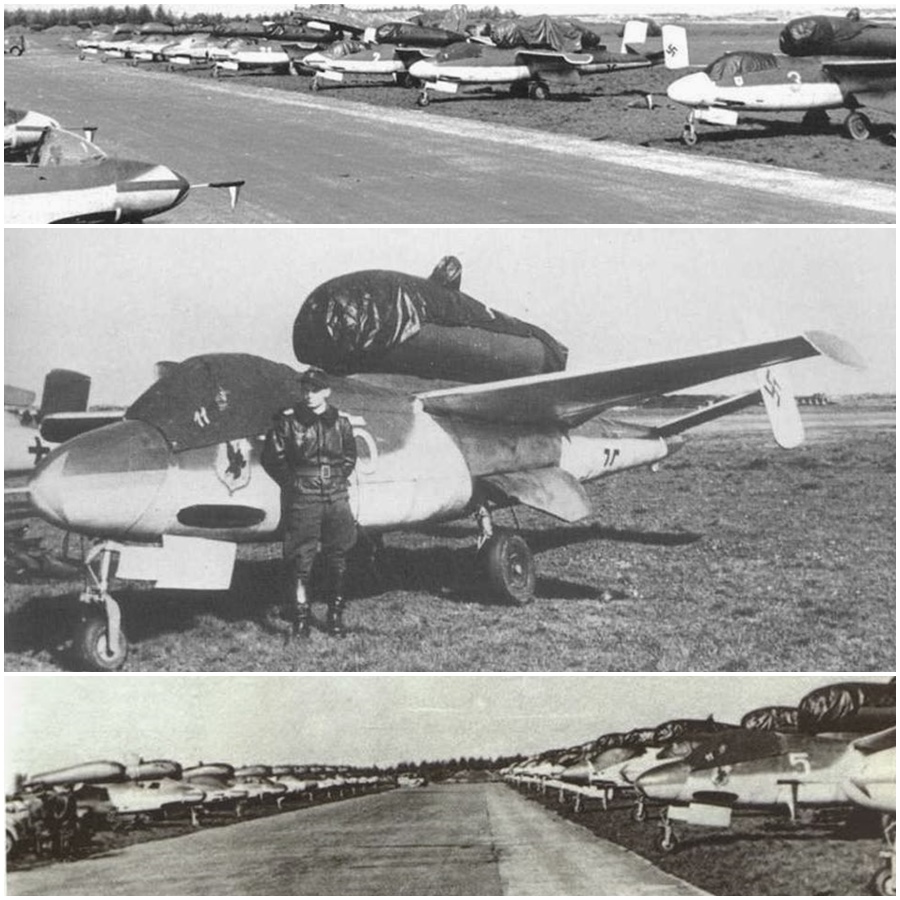
Allied test pilots found the aircraft to be responsive and a good gun platform but production standards were low and as the Germans knew, the flight controls needed to be handled with care. The dangers of early jet flying were evident with the loss of an RAF test pilot flying at the Royal Aircraft Establishment (RAE) Farnborough in November 1945, who must have been over zealous with the rudder control, resulting in the fin and rudder breaking off and a fatal crash.
Survivors
Only 7 surviving Heinkel He 162A Volksjäger examples can be found in museum collections in Europe and North America today (1 A-1 variant and 7 A-2 variants).
Germany
He 162A-2 (Werk Nummer 120076) “Yellow 4” operated by I./JG 1 is located in the Deutches Technikmuseum Berlin (formerly part of the Canadian Aviation and Space Museum collection, it was traded to Aero Vintage in the UK and then to Berlin in 2011). I have not been to this museum since 2010, so I missed out on seeing the Volksjäger in its home country!
United States
The two surviving He 162 aircraft on display in the United States were captured by the British at Leck, Germany in 1945. They were sent to France and were shipped aboard the Royal Navy aircraft carrier HMS Reaper for USAAF flight testing at Freeman Field in Indiana.
He 162A-2 (Werk Nummer 120077) “Red 1” is on display at the Planes of Fame museum in Chino, California and was acquired in the 1950’s. This great collection is well worth checking out for its rare German and Japanese Axis aircraft.

Most likely built at the Heinkel North factory, Rostock in April 1945, He 162 Werk Nummer 120077 was flown by Lieutenant Gerhard Hanf of II./JG 1 until the end of that month and features the apt word “Nervenklau” painted below the cockpit on the left side of the fuselage which translates to “Nerve Jangler“. This nickname was applied by ground crew who took a tongue in cheek attitude to Hanf’s noisy motorbike, which apparently disturbed their barracks rest on a regular basis!
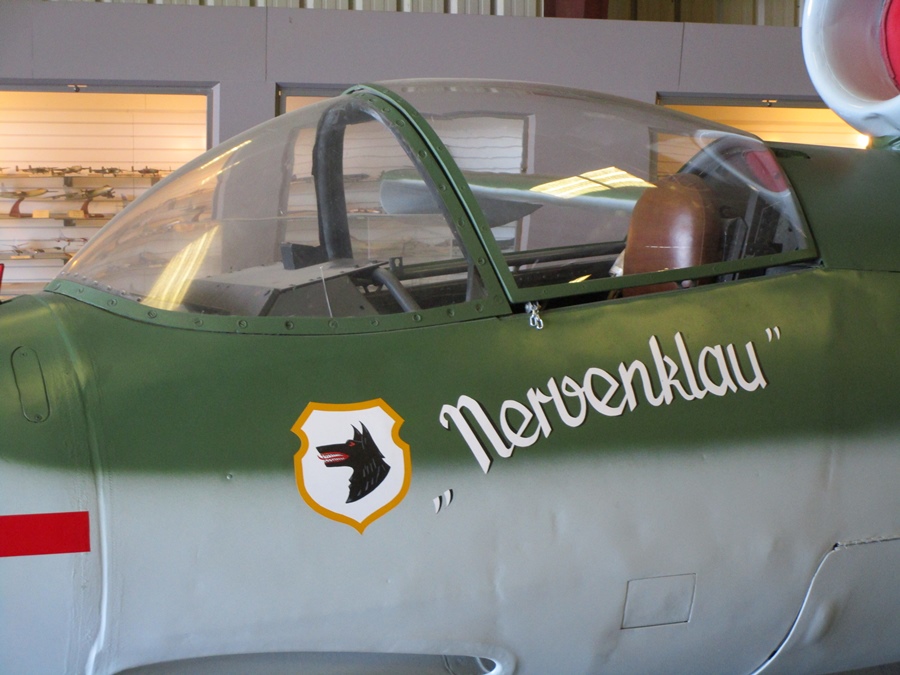

After capture and being sent to the United States for USAAF flight testing, the aircraft was given the Foreign Equipment number FE-489 (later T-2-489). Initially at Freeman Field, Indiana, the aircraft was transferred to Muroc Dry Lake in California in 1946 (Edwards Air Force Base today). With testing finished the He 162 was donated to the University of Kansas in 1947, then was sold in 1948 to Eddie Fischer in Kansas City, Kansas and later sold to the Planes of Fame museum.



He 162A-2 (Werk Nummer 120230) “White 23” of I./JG 1 (with the tail from Werk Nummer 120222) is within a Smithsonian National Air and Space Museum storage facility – the last known location was Paul E. Garber Preservation, Restoration, and Storage Facility at Silver Hill in Washington D.C. (since 1955) but much of that collection is being moved to a new facility. Built at the Heinkel Nord plant in Rostock-Marienehe, Germany in 1945 the aircraft was taken to the United States in 1945.
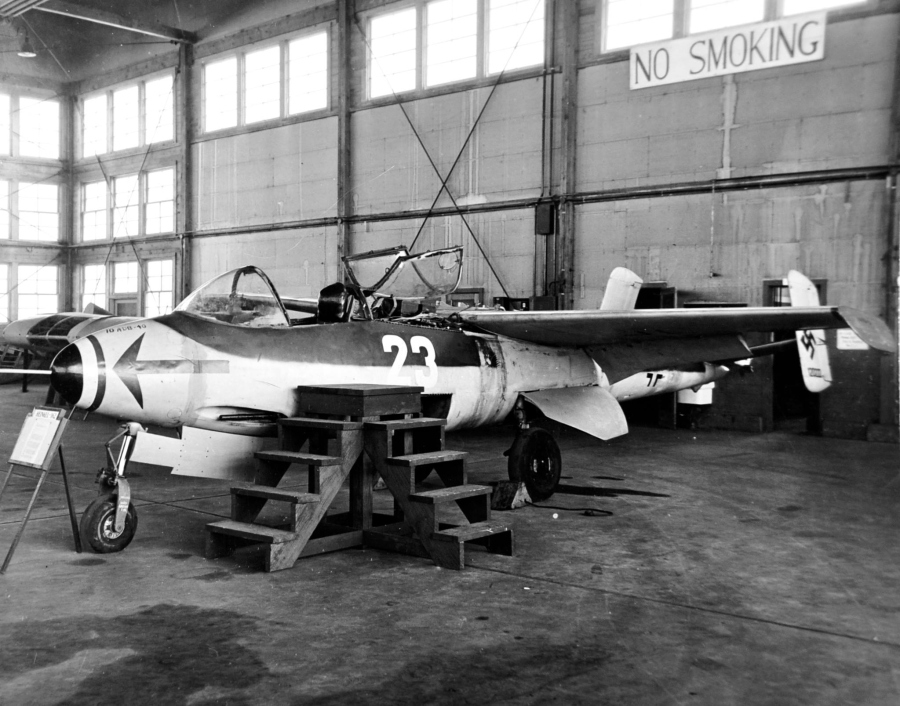
It was first shipped to Wright Field, Ohio for evaluation and assigned the Foreign Equipment number FE-504 (later T2-504) – for reasons unknown this is where the tail unit of the different aircraft was fitted. The aircraft later found its way to Freeman Field, Indiana for flight testing but was never flown and from 1946 was lugged around by the USAAF for ground display at various air shows and military displays, until transferred to the Smithsonian collection in 1949, where it has unfortunately been in storage ever since.
Canada
He 162A-2 (Werk Nummer 120086) “Yellow 2” of JG 1 is on display at the Canadian Aviation and Space Museum in Ottawa, Ontario. I saw this aircraft on a visit to Canada in 2013. It was displayed in an unrestored state.
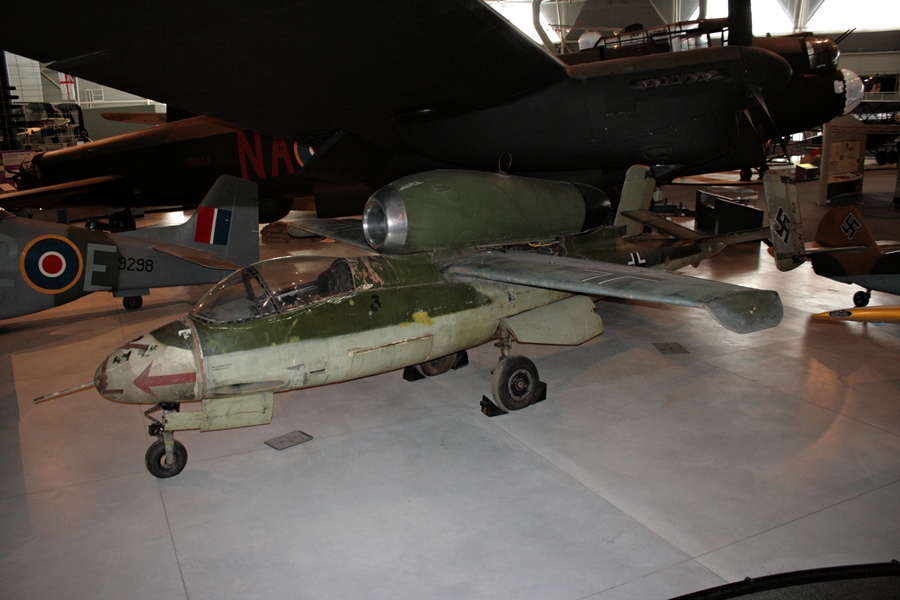



This He 162A-2 was manufactured at the Heinkel Nord plant in Rostock-Marienehe, Germany in February or March 1945 and was captured by the British at Leck on May 8th, 1945. Following display as a war trophy and then storage in England, it was presented to the Royal Canadian Air Force and shipped to Canada in 1946. After years in storage it was refurbished and transferred to the Canada War Museum in 1964 and then the current museum in 1967.

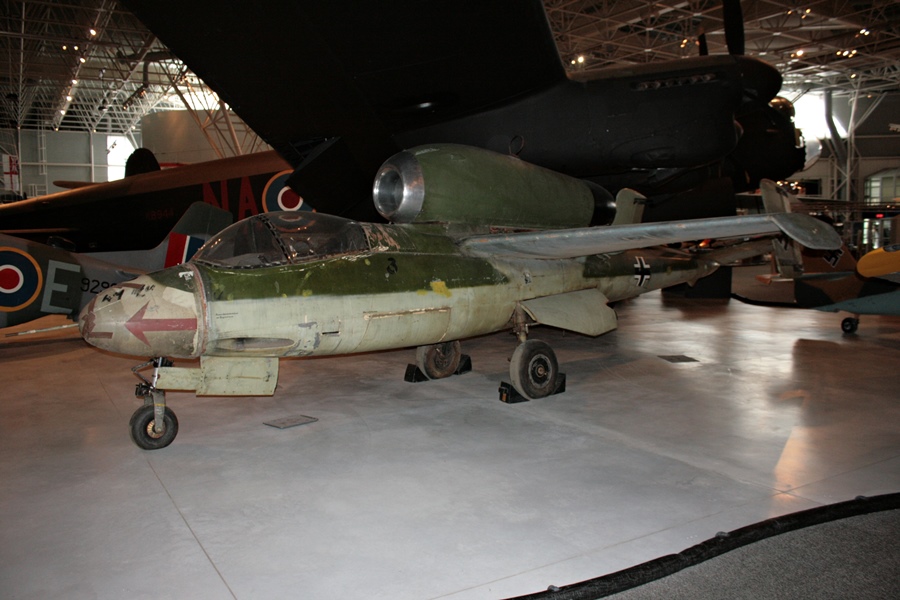

France
He 162A-2 (Werk Nummer 120015) “Yellow 1” of JG 1 is being restored as part of the Musee de l’Air collection at Le Bourget in Paris, France. Although I went to this museum in 2012, which is a treasure trove of French aircraft in particular, unfortunately the Volksjäger was not on display at the time. Post war, this particular aircraft was test flown approximately 30 times in French markings.

United Kingdom
He 162A-2 (Werk Nummer 120227) “Red 2” of JG 1 is on display within the hallowed halls of the RAF Museum Hendon. I last saw this aircraft in 2012 and it was evidently well preserved, looking like it had just come off the production line in the Luftwaffe markings of JG 1!
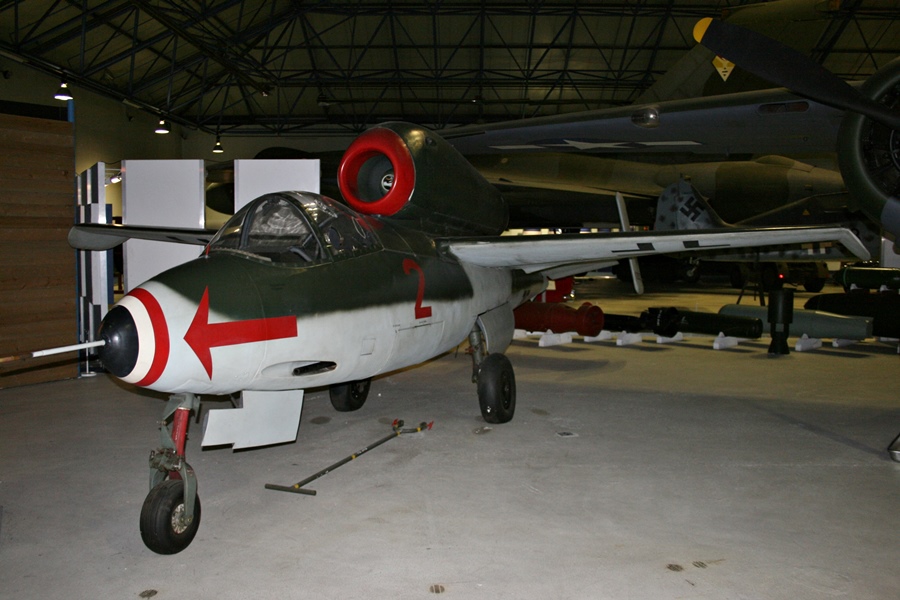
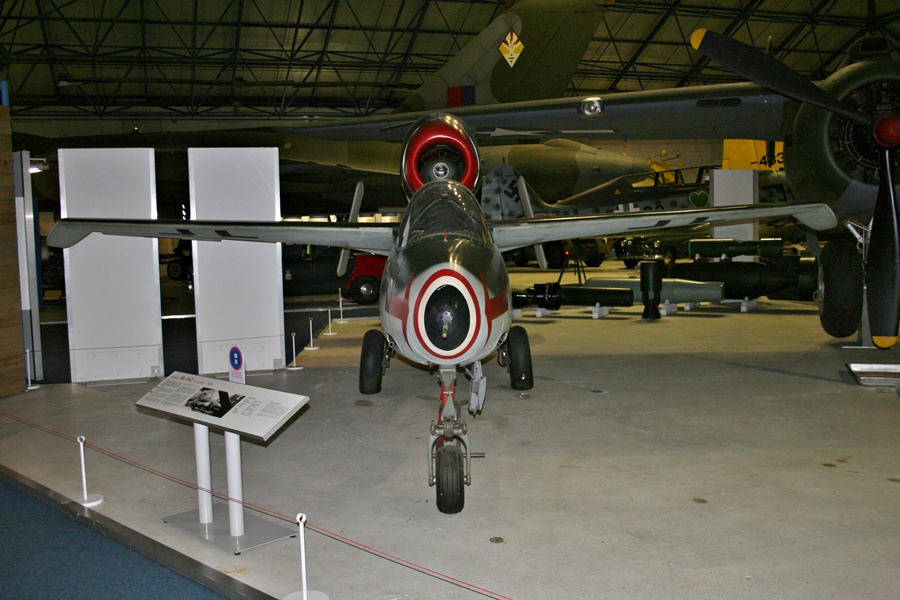

Manufactured at the Heinkel Nord plant in Rostock-Marienehe, Germany in April 1945 and captured at Leck, Germany on May 6th, 1945, this RAF Museum example was taken back to England for flight testing, completing 26 sorties over 11 hours and 45 minutes of flying time. Somewhere along the way the ejector seat was removed and unfortunately lost.
Destined for the scrap yard in 1946, the aircraft was saved and spent many years in and out of storage as part of RAF base historical collections and occasionally on display at various RAF events. Restorative work was conducted on the aircraft at RAF Colerne between 1974 and 1976. Finally in November 1989 the He 162 was transferred to the RAF Museum Hendon collection and displayed in the Bomber Command Hall.
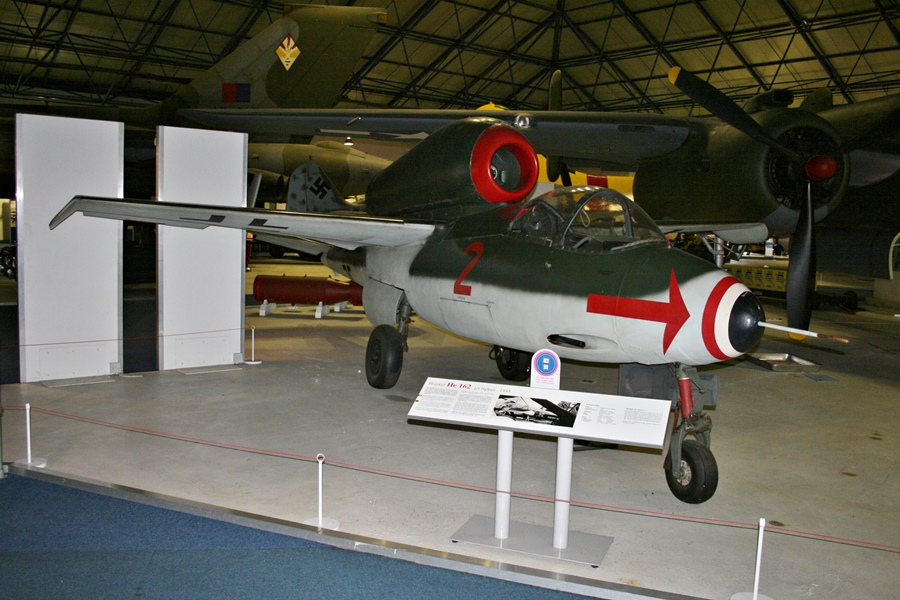

He 162A-1 (Werk Nummer 120235) “Yellow 6” of JG 1 is currently displayed at the Imperial War Museum Duxford (since October 2012, following the commencement of renovations at IWM London). I saw it when it was suspended in the Imperial War Museum London in June 2012 – an amazing collection of military technology from both World Wars was displayed in a relatively small atrium! This is another of the captured Leck examples, it was reported to have been test flown by RAE Farnborough in 1945/46 before going into storage for many years before being displayed by the Imperial War Museum.



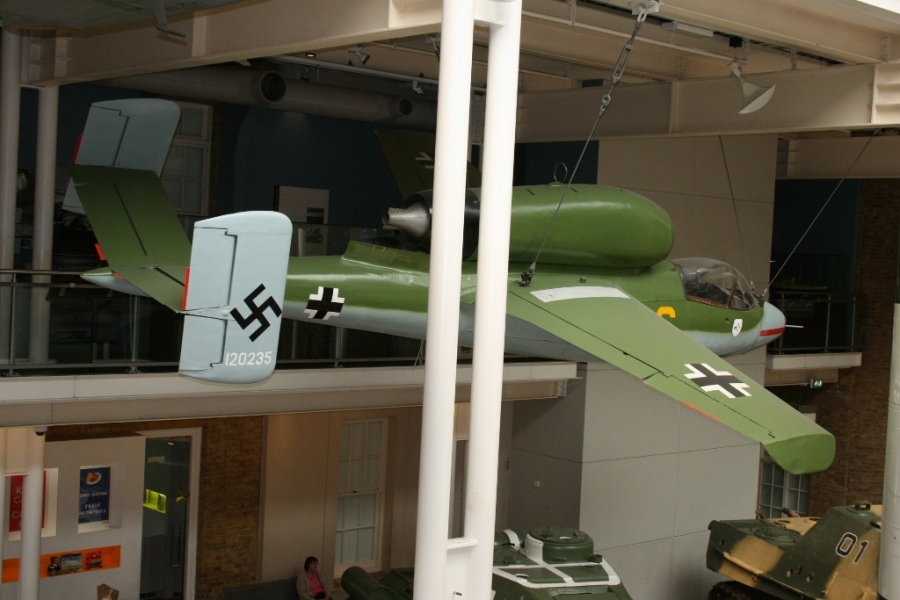
References:
The Aviation History Online Museum – Heinkel He 162
Canada Aviation and Space Museum – He 162A
Classic Wings: Preserved Axis Aircraft – He 162
Combat Aircraft by Robert Forsyth (2016 Osprey Publishing)
History of War – Heinkel He 162
Imperial War Museum – Heinkel He 162A-1 Salamander
Smithsonian National Air and Space Museum – Heinkel He 162A-2 Spatz (Sparrow)
Splash One – The Story of Jet Combat by Ivan Rendall (1999 Edition)
The Luftwaffe in Scale – Heinkel He 162A-2 Profile
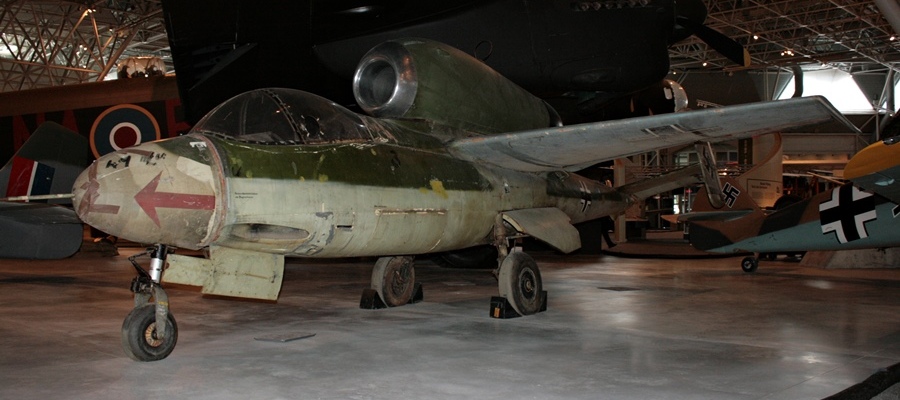
Another impressive research. I especially like the photos taken in Canada in 2013.
LikeLike
Thanks Pierre. That’s a great museum collection!
LikeLike
Interesting history of how aeronautical technology advanced so fast. German prototype work was far advanced than the allies. Lucky that they ended the war at that stage.
LikeLiked by 1 person
The next generation of jets they were working on heavily influenced the F-86 and MiG-15
LikeLike
You would have to be very, very, desperate, and very fanatical to get into one of those things.
LikeLiked by 1 person
Desperate times for sure!
LikeLike
Great post! I had no idea there were so many samples left! To me the He-162 was always a sign of the desperation Germany faced by the end of the war – it would have been a death trap for the inexperienced young pilots they imagined they could get flying it. On the other hand, from a pure aviation perspective it was quite ingenious in terms of the fact that Heinkel managed to get some really good performance out of an aircraft using largely non-strategic materials.
LikeLiked by 1 person
Thank you. Groundbreaking, terrifying and highly dangerous all in one!
LikeLike
A very interesting account indeed! It would appear that some of your photo links are not to where you intended, the captions not reflecting the rather good photographs. Feel free to delete this comment if you wish.
LikeLike
Oh, thanks. Which photos?
LikeLike
Not a problem. It’s quite a few of the ones you took. For example, the first one appears to be a series of Soviet jets and a helicopter. It looks like a montage of photos.
LikeLike
Bizarre, do you mean if you click on an image?
LikeLike
I dont see any issues on my version
LikeLike
Maybe it’s something to do with my device then. Sadly I can’t send a screenshot on here so you can see. I shouldn’t worry, it could be the device I’m using, it’s all far too complicated for me to understand.
LikeLike
What about the one currently for sale on milweb?
LikeLike
If it is the post that has been floating around for some time, to my knowledge it is essentially a replica using some original parts.
LikeLike